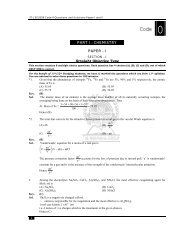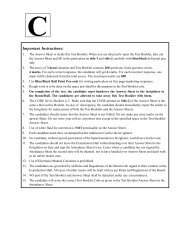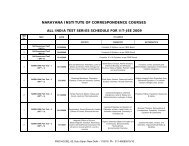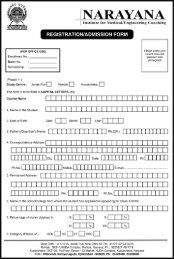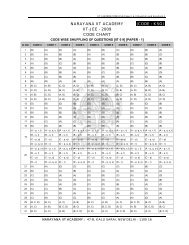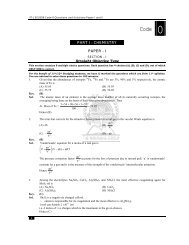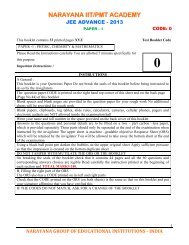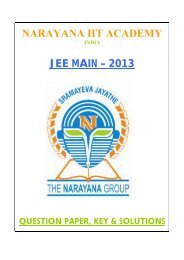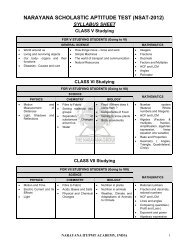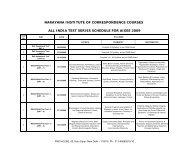NARAYANA IIT/PMT ACADEMY - Narayanaicc.com
NARAYANA IIT/PMT ACADEMY - Narayanaicc.com
NARAYANA IIT/PMT ACADEMY - Narayanaicc.com
Create successful ePaper yourself
Turn your PDF publications into a flip-book with our unique Google optimized e-Paper software.
<strong>NARAYANA</strong> <strong>IIT</strong>/<strong>PMT</strong> <strong>ACADEMY</strong><br />
JEE ADVANCE : 2013<br />
(PAPER – II) CODE: 0<br />
2<br />
o mv<br />
N mgcos60<br />
R<br />
N 7.5N<br />
Paragraph for questions 11 and 12<br />
A thermal power plant produces electric power of 600 kW at 4000 V, which is to be transported to a<br />
place 20 km away from the power plant for consumers’ usage It can be transported either directly with a<br />
cable of large current carrying capacity or by using a <strong>com</strong>bination of step-up and step-down<br />
transformers at the two ends The drawback of the direct transmission is the large energy dissipation In<br />
the method using transformers, the dissipation is much smaller In this method, a step-up transformer is<br />
used at the plant side so that the current is reduced to a smaller value At the consumers’ end, a stepdown<br />
transformer is used to supply power to the consumers at the specified lower voltage It is<br />
reasonable to assume that the power cable is purely resistive and the transformers are ideal with a power<br />
factor unity All the currents and voltages mentioned are rms values<br />
11 If the direct transmission method with a cable of resistance 04 km -1 is used, the power<br />
dissipation (in%) during transmission is<br />
(A) 20 (B) 30 (C) 40 (D) 50<br />
Ans (B)<br />
Sol P<br />
3<br />
600 10 watt<br />
Vrms<br />
4000 volt<br />
Total resistance R = 04 20 = 80<br />
Power lost P<br />
2<br />
I R<br />
L<br />
P<br />
V<br />
rms<br />
rms<br />
2<br />
R<br />
= 180000 watt<br />
= 180 kW<br />
So % loss = 180 600<br />
100 30<br />
= 30%<br />
3<br />
600 10<br />
4000<br />
12 In the method using the transformers, assume that the ratio of the number of turns in the primary<br />
to that in the secondary in the step-up transformer is 1 : 10 If the power to the consumers has to<br />
be supplied at 200 V, the ratio of the number of turns in the primary to that in the secondary in<br />
the step-down transformer is<br />
(A) 200 : 1 (B) 150 : 1 (C) 100 : 1 (D) 50 : 1<br />
Ans (A)<br />
Sol Step – up<br />
2<br />
8<br />
<strong>NARAYANA</strong> GROUP OF EDUCATIONAL INSTITUTIONS - INDIA<br />
7




